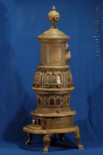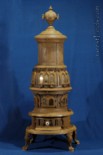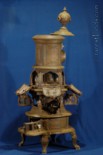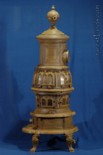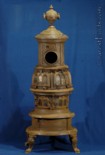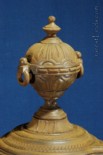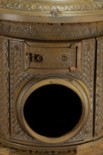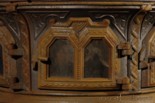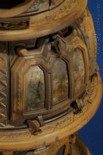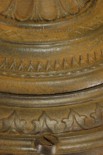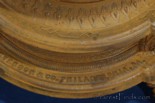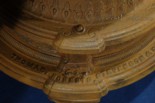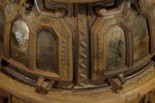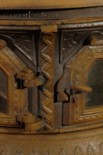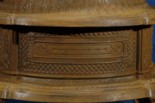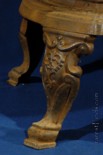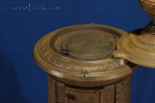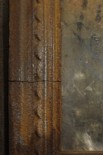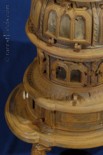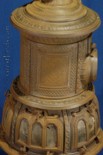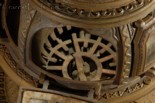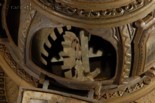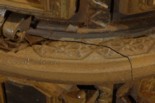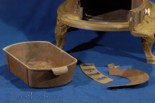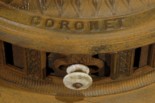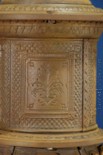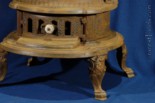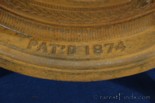Exceedingly rare, maybe the only one that survived, CORONET Base Burner stove, patented in 1874, and manufactured by Thomas, Roberts, Stevenson Co., in Philadelphia, PA, USA. Sold!
I have been in the antique business for 37 years and have seen thousands of stoves. If I see a stove I have never seen before and it looks early and interesting, I pause. This stove made me pause! I did research on the Internet and could not find any information on a CORONET made by Thomas, Roberts, Stevenson, Co., so I purchased the stove. Doing research on the Internet, I realized that base burner stoves from the 1870's are basically none extant; the only images I could find were images on trade-cards or images out of sales-catalogs from the time. Interestingly paper does survive, the stoves obviously got scrapped. Hence, this stove is probably the only one which survived.
This rare stove has the model “CORONET” cast into the frame just above the door to access the ash-bin, see picture #25. Around the back, cast into the base, is the manufacturer´s name and town of business, Thomas, Roberts, Stevenson, Co., Philadelphia, PA, see pictures #11 and 12. There is also the year of the patent (1874) cast into the frame of the stove as shown in picture #28. This stove stands 49.75 inches high, including the finial. Two circular tiers at five doors each with three Mica windows on the upper tier, and five doors with two windows each at the lower tier, provide plenty of access to the inside of the stove.
Condition:
This stove is in remarkable good condition! However, there is no cast iron stove, 100 plus years old, without issues....
I found two cracks, not breaks! One crack is along the outside of the ring on the mid-section as shown in picture #23 and #21. These rings, if not properly designed, did heat up more on the side towards the fire, the inside, and expand more on the outside of the ring. As a result, these rings cracked as the cast iron expanded unevenly. There is also a crack in the frame of one of the Mica windows, see picture #18. The stove has been sand-blasted some time ago and then left bare metal, fortunately inside, protected from the elements! I cleaned it with a small brass brush. The cast iron burning chamber inside holding the fuel has a small hole from over-heating. Two of the doors on the upper tier I was unable to open; instead of forcing anything and may break something, I choose to leave them closed. It will be simple to take the pins out of the hinges and simply remove the doors that way.
Picture #7 shows a small damper which I was also unable to open. If there was some sort of inner tin-liner, and this damper was to create some sort of down-draft inside, this liner is rusted away and gone... Picture #21 and #22 show the grate which can be tilted by a lever from the outside by 90 degrees.
A couple of parts which were inside the dust-bin may belong to this stove or maybe not; I was unable to place them, they may not belong to this stove? The parts are shown in picture #24. The original ash-bin is present. I chose not to spray-paint the stove to make it look better as the potential buyer will want to expertly restore this Jewell.
History:
Base Burning Stoves, or Base Burners are based on the principle of an elevated buring chamber above a crate in the lower part of the stove and a column above it to store the fuel. The fuel, mostly coal, is stored in its elevated chamber or "magazine" from where it settles into the fire as the fuel at the bottom is consumed. The ash is falling trough the crate into the ash bin at the bottom of the stove.
Early Base Burners are fitted with windows made of Mica, hence, the term illuminated stoves, or radiant stoves. The idea of an illuminated stove goes way back to the year 1807 when Allan Pollack patented his idea as “a projecting window on an outstanding stove.” Dr. Nott patented a special sash for the Mica to illuminate the front of his stoves in 1833.
These round base burner stoves are literally none extant any more, the few of these early base burner heathers which were ever built and sold, have long been replaced and scrapped for later and better models. In the literature and On-line, all you will find are images of stoves like this stove, on trade-cards, and stove trade-catalogs from the time. On page 138 and 139 of the book FIRE on the HEARTH, The Evolution ad Romance of the HEATING-STOVE, by Josephine H Peirce, you will find two images of early base burner stoves from the mid late 1870's. One trade card shows an image of the Garland with the clinkerless grate, manufactured by Perry & Co., Albany, NY (Plate 87; and the other stove shown is a Gold Coin Base Burner manufactured by Bussey, Mcleod & Co., Troy, NY (Plate 88). In the book, CAST WITH STYLE, Nineteenth Century cast-iron Stoves from the Albany Area, on page 78, figure 91. is an image of a Silvio base-burner stove manufactured by Burdett, Smith & Co., Troy & Chicago. The Silvio base burner comes close to the CORONET base burner stove offered here; however, the SILVIO stove dates to ca. 1890, the CORONET to ca 1875. During the 15 years between 1875 and 1890, a lot of improvements were made to base burner stoves and the production numbers of base burner stoves increased dramatically. The two stoves can therefore not be compared.
I found this information on the Internet (Sanitary and Heating Age, Volumes 7-8, page 422, dated January 13, 1877), which mentions the Coronet base burner offered here. Thomas, Roberts, Stevenson & Co. offered a large variety of cast iron stoves, a total of 18 different stove models were added to the program. It is not clear how many different stove models were already manufactured the year before:
Thomas, Roberts, Stevenson & Co., Philadelphia, send us a plain but neat and well arranged catalogue, which invites a few words of commendation as it gives a good deal more information about the stoves illustrated than is usually found in catalogues. Since last year they have added the following to the list of their stoves, ranges and furnaces: "None Such" and "Magnolia" base burning parlor stoves; "Boxer," plain and high top; "Coronet," improved, with a dust flue; "Parlor Cabinet," "Commander," "Champion," "Dom Pedro," "Topic," and "Famous Grand" ranges; "Southern Baker," "Chief Cook," "Premium" and "O. K. Premium" cook stoves; "Globe," and "Volcano" heaters; and "Home Comfort" range improved, with open fire and clinker clearing grate.
Inventory Number 00998;
Sold!
